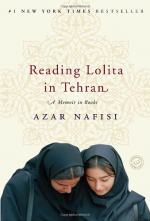
|
| Name: _________________________ | Period: ___________________ |
This test consists of 15 multiple choice questions and 5 short answer questions.
Multiple Choice Questions
1. What do Nafisi and the magician share on their first meeting in his apartment?
(a) Newspapers from foreign countries.
(b) Coffee and books.
(c) A foreign movie.
(d) Tea and a box of foreign chocolates.
2. Why does Professor R. continue to participate in vigils at the University of Tehran after he resigns from his position?
(a) He believes that the university needed to know how strongly he felt about his actions.
(b) He wants his students to see him as a political figure and an inspiration for their own political choices.
(c) He wants his students to know he did not leave because he was afraid the government would persecute him.
(d) He is angry with the university's decision to change the curriculum, and wants to punish the leaders for their decision.
3. Why do the students begin to keep vigils at the University of Tehran?
(a) They are protesting the expulsion of their favorite professors.
(b) To prevent the university from being closed down by the government.
(c) They are tired of going to class and want to be part of the Revolution.
(d) To encourage the government to close down the university.
4. Why does Nafisi include the scene from "Invitation to a Beheading" in Chapter 22?
(a) It illustrates the way totalitarian governments force victims to participate in crimes against themselves.
(b) The scene was just studied in Nafisi's study group.
(c) Nafisi believes that scene shows how her students will be mistreated if they are thrown in jail.
(d) She is making the point that all governments are corrupt.
5. What happens to Sanaz when she is on vacation?
(a) She is expelled from the university because she is in Nafisi's study group.
(b) She is kidnapped by her brother, who accuses her of being too Westernized.
(c) Revolutionary Guards search the house where she is staying and take her to jail for 48 hours.
(d) She decides that she can no longer participate in the goals of the revolution.
6. Who is Mike Gold?
(a) Nafisi's first literature student at the University of Tehran.
(b) The editor of a radical literary journal and the subject of Nafisi's dissertation.
(c) The chair of the English Department at the University of Tehran.
(d) Nafisi's first husband and a leader in the Iranian Revolution.
7. What is Hizbollah?
(a) The title of a religious tract that all Iranians must follow according to the regime leaders.
(b) A group of radical Muslims who murdered the Ayatollah Taleghani.
(c) The name of a radical student organization at the University of Tehran.
(d) A religious group also known as the Party of Allah, who are determined to put God's laws into practice on earth.
8. In Part 4, Chapter 12, where do Nafisi and her husband go?
(a) To a concert.
(b) To the movies.
(c) To a lecture by a famous author.
(d) To a cafe.
9. What activity does Nafisi do with her students to help them understand the characters in Jane Austen's "Pride and Prejudice"?
(a) She takes them to a cafe.
(b) She asks them to write descriptions of the main characters.
(c) She puts the main character on trial.
(d) She dances with them.
10. Who does Nafisi consider to be the "real protagonists" in her class?
(a) Outsiders, including former students, who come because of their commitment to literature.
(b) The novels that are read.
(c) The young women who register for the course.
(d) The members of the Muslim Student Association.
11. What question does Nafisi ask at the beginning of her first class at the University of Tehran?
(a) Why do you believe there will be a cultural revolution?
(b) Why should anyone read fiction?
(c) What did you think about the choice of books for this course?
(d) Why is it important to get a college education?
12. What teaching technique does Nafisi use in conjunction with the study of "The Great Gatsby"?
(a) She chooses students to lead the class discussion.
(b) She teaches the novel using the Socratic method, which the students have never seen before.
(c) Nafisi asks the students to construct character sketches of the novel's main characters and compare the sketches to their own lives.
(d) The class puts the novel on trial, choosing people to play the roles of lawyers, judge, and jury.
13. In Part 3, Chapter 3, what do Laleh and Nafisi discuss at the restaurant?
(a) The actions of the Committee on Cultural Revolution.
(b) Laleh's decision to become a seamstress.
(c) Nafisi's expulsion from the University of Tehran.
(d) Laleh's expulsion from the University of Tehran.
14. Why does Nafisi form a friendship with Jeff?
(a) Because her relationship with her husband is strained, and she is lonely.
(b) They both enjoy having a friend who speaks English and has memories of America.
(c) They are both actively demonstrating against the Iranian government.
(d) Jeff is one of her best students, and they enjoy discussing literature together.
15. Who is Mrs. Rezvan?
(a) One of Nafisi's former students.
(b) The mother of one of Nafisi's former students, who tries to get Nafisi to start a study group.
(c) The wife of one of Nafisi's former students.
(d) A colleague of one of Nafisi's former students, who tries to get Nafisi to return to teaching.
Short Answer Questions
1. What happens to Nassrin after she leaves Iran?
2. What does Nafisi describe as "the most unforgivable crime in fiction"?
3. How is Nafisi's generation different from that of her students?
4. In Part 3, Chapter 4, who asks to meet with Nafisi?
5. What does Nafisi teach during her first semester as a professor at the University of Tehran?
|
This section contains 992 words (approx. 4 pages at 300 words per page) |

|




